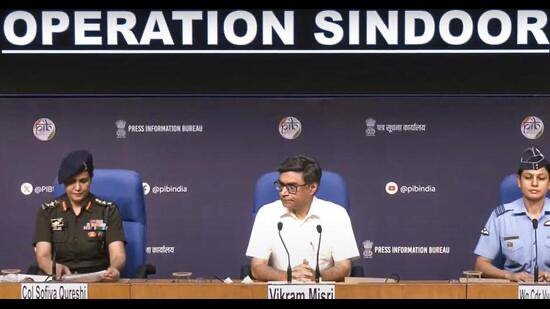In a decisive show of strength and resolve, India on Wednesday launched precision strikes on nine terror camps across Pakistan and Pakistan-occupied Kashmir (PoK), targeting infrastructure belonging to Lashkar-e-Taiba (LeT) and Jaish-e-Mohammed (JeM). Foreign Secretary Vikram Misri described the operation as a “measured, non-escalatory and proportionate” response to the brutal Pahalgam terror attack that killed 26 civilians, including a Nepalese national.
The Indian government’s swift military retaliation followed intelligence inputs that Pakistan-based terror modules were plotting further attacks. Misri said these pre-emptive strikes were not just a message of retribution but a calculated move to dismantle and disable the infrastructure that fuels cross-border terrorism.
“The strikes focused on disabling terrorist camps in territories under Pakistan’s control,” Misri stated during a special briefing. “These actions align with the UN Security Council’s April 25 statement that called for the perpetrators, organisers, financiers, and sponsors of the Pahalgam terror attack to be brought to justice.”
Indian strikes were carried out at Muridke and Bahawalpur in Pakistan’s Punjab province and Kotli and Muzaffarabad in PoK—areas long known to harbour terror infrastructure. Pakistani authorities acknowledged casualties, with eight reported dead and 35 injured. In response, Pakistan’s Prime Minister Shehbaz Sharif termed the Indian action an “act of war” and warned of retaliation.
The media briefing, which began with a chilling video montage of past terror strikes on Indian soil, featured two frontline women officers—Col Sophia Qureshi of the Indian Army and Wing Commander Vyomika Singh of the IAF—who outlined the operational planning and target selection for the strikes.
Misri squarely blamed the Resistance Front (TRF), a proxy of LeT, for orchestrating the April 22 Pahalgam attack. The attackers, Misri revealed, showed barbaric intent by executing victims with close-range headshots in front of family members, a tactic aimed at sowing fear and trauma. “This was not just murder; it was psychological warfare,” Misri said, adding that the attackers deliberately sought to send a chilling message to the people of Jammu and Kashmir.
The goal, according to Misri, was to derail Kashmir’s recovering economy and growing tourism sector, which saw a record 23 million visitors last year. “They intended to create communal discord and disrupt normalcy in Jammu and Kashmir and the rest of India. But these designs were foiled,” he added.
India has been highlighting TRF’s role as a front for Pakistan-based terror outfits at global forums. In 2024, the government submitted two reports to the UN’s 1267 Sanctions Committee, naming TRF as a “cover organisation” for LeT and JeM. Pakistan, on the other hand, has continued to deny any involvement while pressing the UN to erase references to TRF—an effort India flagged as telling.
“Even after two weeks, there was no demonstrable action by Pakistan against the perpetrators of the attack. What we got were denials, deflections and inflammatory rhetoric,” Misri said. “Our strikes were a calibrated response in line with international law and expectations.”
He further cited Pakistan’s global reputation as a “safe haven for terrorists,” mentioning the case of Sajid Mir—an LeT handler involved in the 26/11 Mumbai attacks—who was long declared dead by Pakistan only to be resurrected and arrested under international pressure. “That’s the kind of duplicity we’re dealing with,” Misri remarked.
Following the Pahalgam attack, India took a series of retaliatory steps, including the suspension of the Indus Waters Treaty and closure of the Attari land crossing, the only functioning land trade route between the two countries. These diplomatic and economic measures were designed to isolate Pakistan globally and pressurise it to act against terror groups operating on its soil.
Pakistan responded with a mix of symbolic and military gestures—shutting down its airspace for Indian airlines, suspending bilateral trade, and conducting military drills, including missile tests.
However, the Indian government remains firm. “Our objective is clear: to protect our citizens, safeguard our territory and ensure that the cost of sponsoring terrorism is unacceptably high,” Misri concluded.
As both sides brace for heightened diplomatic tension, New Delhi has made it clear that it is no longer content with passive condemnation or reactive diplomacy. The era of strategic restraint appears to be evolving into one of calibrated response—with international law, intelligence precision, and geopolitical messaging all working in concert.








 India
India












